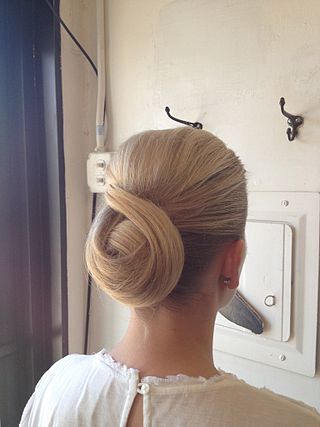Top Qs
Timeline
Chat
Perspective
Chignon (hairstyle)
Women's hairstyle From Wikipedia, the free encyclopedia
Remove ads
A chignon (UK: /ˈʃiːnjɒ̃/, US: /ˈʃiːnjɒn/, French: [ʃiɲɔ̃]), from the French chignon meaning a bun, is a hairstyle characterized by wrapped hair on the back of the head. In the United States and the United Kingdom, it is often used as an abbreviation of the French phrase chignon du cou, signifying a low bun worn at the nape of the neck.[1][2][3]
This article has multiple issues. Please help improve it or discuss these issues on the talk page. (Learn how and when to remove these messages)
|

Chignons are generally achieved by pinning the hair into a knot at the nape of the neck or at the back of the head, but there are many variations of the style.[4] They are usually secured with accessories such as barrettes or hairpins.[5] Chignons are frequently worn for special occasions, like weddings and formal dances, but the basic chignon is also worn for everyday casual wear.
Remove ads
History
The chignon can be traced back to ancient Greece, where Athenian women commonly wore the style with gold or ivory handcrafted hairpins. Athenian men wore the same style, but they fastened their chignons with a clasp of "golden grasshoppers", according to The History of the Peloponnesian War, by Thucydides. The chignon was specific to Athens, as other city states, such as Cyprus and Sparta, had their own styles of hairdressing.[citation needed] The chignon was also popular in ancient China, where married women wore the low, knotted hairstyle.[citation needed]
Male writers of the Victorian era, like Anthony Trollope, were fond of poking fun[6] at the perceived absurdity of the fashion, which was much in vogue in England in the 1860s. In the 1890s, the dancer Cléo de Mérode popularized the hairstyle in France.[7][8][9]
Remove ads
See also
References
Bibliography
External links
Wikiwand - on
Seamless Wikipedia browsing. On steroids.
Remove ads
